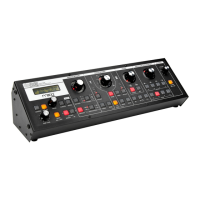Page 7
Slim Phatty User’s Manual - The Basics
Set up
Make sure you have an adequate place to set up. Do not expose your Slim Phatty to dripping or splashing and no
objects filled with liquids, such as vases, should be placed on top of it.” Use care when unpacking the Slim Phatty,
and be sure to save the carton and all packing material in case you need to ship the Slim Phatty for any reason.
Connect to Power & MIDI
Connect the Slim Phatty’s power receptacle to a properly-wired wall outlet using the supplied AC power cord.
Warning: An apparatus with CLASS I construction (such as this device) shall be connected to a MAINS socket
outlet with a protective earthing connection. The Slim Phatty's universal power supply will operate with a power
source from 100 to 250 Volts AC, 50/60Hz, 12-16W. Using a standard MIDI cable, make the connection between
the MIDI OUT of your MIDI controller and the MIDI IN on the Slim Phatty. As shipped from the factory, the Slim
Phatty is set to receive messages on MIDI Channel 1. If you are using USB MIDI with a Windows or Macintosh
computer, connect the USB cable from the Slim Phatty to a USB port on your computer. Once the SP’s USB drivers
are automatically installed, the SP will appear as a ‘USB Audio Device’ in the MIDI Device selection options of the
computer’s MIDI software.
Power up
Apply power to the Slim Phatty and your MIDI controller. You will see the LCD screen on the Slim Phatty light
up and display the message:
Slim Phatty
Version X.x
After a few seconds the start-up screen will disappear and the current preset will appear in the display. The
PRESET button will be illuminated in red, the name of the current preset location and preset name will be
displayed on the top line of the LCD screen, and the message ‘PRESET ACTIVE’ will be displayed on the lower
line of the LCD screen.
Connect to %QTPM½IV
Set the Slim Phatty’s Volume control to minimum before connecting to an ampli½er or headphones. Adjust the
ampli½er level for a comfortable listening level, and then slowly bring up the Slim Phatty’s volume. Make sure the
OUTPUT ON/OFF switch is illuminated – this means the output is turned on.
Start Playing
Use the VALUE knob to scroll through the presets. All preset locations (00 – 99) are loaded with sounds from
the factory. There are a total of 100 locations in memory for presets – all are user programmable. Note that
once a preset is called up, you can tweak the parameters to your liking using the front panel controls. Any
changes made to the current preset will cause the PRESET button to change its illumination from red to amber,
and the lower line of the LCD screen will change to ‘PANEL ACTIVE’. If you make changes to a preset and want
to return to the original sound, press PRESET. You can toggle between the stored preset and the current edited
preset by pressing the PRESET button until you change presets. If you wish to save your changes – refer to the
section on Storing Presets on page 24. Any changes made to a preset will be lost if they are not saved once you
change to a new preset.
Warranty registration
Moog’s on-line warranty registration system is the best way to activate your warranty
. Access the Moog
web site at www.moogmusic.com and click on the “Product Register” tab. If you complete all the requested
information, Moog Music will send you a complimentary gift.
NOTE: It is recommended that a warm up period of about 15 minutes be allowed before using the SP
.
The SP’s VCOs use a heated chip design that take a short time to warm up. The warm up period may
be longer if the SP has been stored outside the recommended operating temperature range.
The Slim Phatty is recommended for an operating temperature between about 50 and 100 degrees
Fahrenheit. It is safe to operate the synthesizer outside of this range (between 0 and 125 degrees F),
but the SP’s voltage controlled oscillators (VCOs) may not remain in tune. It is recommended that
the SP’s case not be exposed to direct sunlight while operating the unit as the tuning of the VCOs
may be affected.

